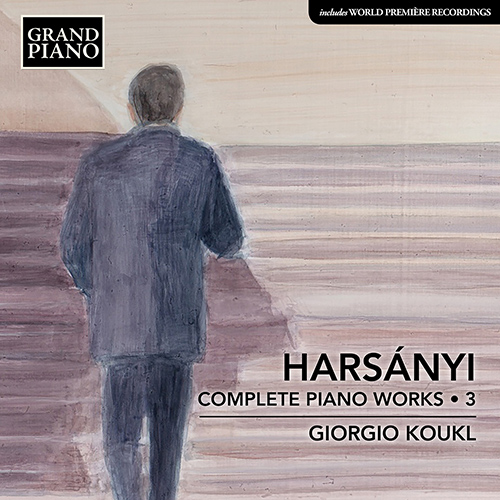Giorgio Koukl, an experienced and much recorded Czech pianist who lives in Switzerland, certainly plays this well. He specializes in relatively neglected composers, and his interpretations of Martinu’s piano music in particular have been praised in these pages. © 2021 American Record Guide Read complete review on American Record Guide
This third disc is, for me, the most interesting of the three, incorporating, as it does, Harsányi’s most complex and thoughtful works. The recording is wonderfully bright and the technician Lukas Fröhlich deserves credit for ensuring that the piano sounds so beautifully responsive to Koukl’s magic touch, as does engineer Michael Rast. Both of them have ensured the continuity of sound quality from the Steinway Model D over all three discs. The teamwork between these three - pianist, engineer and technician - is key in the production of an enjoyable disc, so thanks to them all.
I am sad to leave Harsányi now I have got to know him and I hope others will enjoy discovering yet another unsung composer who deserves much wider exposure which, hopefully, will ensue, following this set. I understand he wrote some chamber music which I am eager to explore as well as some orchestral music, so, for now at least, ”Au revoir Tibor!” © 2021 MusicWeb International Read complete review
This Hungarian composer was one of the leading expatriate composers to form the group known as L’École de Paris. As the Morceaux show, his piano music is notable for its variety of character and genre. The Sonata reveals his enthusiasm for dance rhythms and for joyful lyricism as well as quietly sombre elements, while the Burlesques flirt with jazz. © 2021 Records International
That intrepid Czech pianist Giorgio Koukl, who in my view is one of the five or six greatest living pianists today, has spent most of the latter years of his career playing neglected works by composers who worked in France during the 1920s and ’30s. Tibor Harsányi has been his latest project, and with this Vol. 3 he digs into some of the composer’s meatiest works. It should be noted that everything on this CD except for the short piece from Parc d’Attractions Expo are first recordings.
…these are valuable recordings because they are first issues of most of this music and clearly some of it is quite extraordinary. © 2021 The Art Music Lounge Read complete review
A one-time pupil of Kodaly, the Hungarian-born twentieth century composer, Tibor Harsanyi, lived most of his life in Paris and there wrote all of the works on this disc.
It forms the third release in the complete scores for solo piano, and dates from his first attempt—the 1923 Suite Pour Enfants—to 1952 with the 3 Impromptus. Sadly he was, throughout his composing career, never to achieve the recognition to which he was justified, and died aged just 56. Though not presented in chronological order, the Czech pianist, Giorgio Koukl, has assembled a most attractive programme opening with the four movements of the 1926 Piano Sonata. Harsanyi shows an acceptance of the Second Viennese School of composition in the opening Molto agitato, but the following three movements hardly seem to belong to it. Three years earlier the four movements of the Petite Suite were imbued with the capricious mould of French music of that era with a ‘naughty’ Valsette. Then sharing the disc we have the 4 Morceaux—as part of his tonality world; an engaging Serenade; a noisy final Danse, and a boisterous Rhapsodie from 1924. By the time Harsanyi composed the 1930 Piano Suite, we find he had joined the mainstream of European progressive composers that was largely to colour the remainder of his short life. Once again Giorgio Koukl brings eight world premiere recordings to our attention, his impeccable articulation captured in a recorded sound of real beauty and in a generously filled release. © 2021 David’s Review Corner































